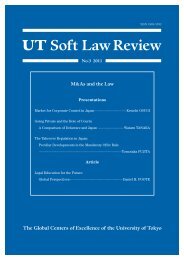UT Soft Law Review
UT Soft Law Review
UT Soft Law Review
Create successful ePaper yourself
Turn your PDF publications into a flip-book with our unique Google optimized e-Paper software.
<strong>UT</strong> <strong>Soft</strong> <strong>Law</strong> <strong>Review</strong> No.2 2010damage and the case of preferential issuance are not quite the same because the situationsbetween the shareholders who would receive the financial benefits and the shareholders whowould suffer the damage would be different. Therefore, we need to examine this issuecarefully.Fujita: Thank you. Mr. Ishiwata’s last point is very important. If the shareholders’ meetingapproves the issuance of stocks to a third party at a preferable price (“preferential issuance”),there should be no problem because the existing shareholders who would suffer the financialdamage agree with it. The person who receives the preferential issuance is the party of specialinterest, so if the person executes the voting right and the resolution was fixed even if thestockholders who suffers the damage, that will be the grounds for the revocation (CompaniesAct article 831(1)(iii)). On the contrary, in the case like Bull-Dog Source, the existingstockholders who will suffer the financial damage (acquirer) were against it and the rest werein favor for it. According to the analogy of preferential issuance, that means only the majorityof stockholders who would receive the preferential issuance are in favor of it. So even if theyare both special resolutions, the two cases have completely different meanings. It is surelymisleading to use the rough comparison to make an argument.The new report of the Corporate Value Study Group also emphasizes the appropriatenessof defense measures without financial benefits and is struggling to justify it. It argued that ifthe defense measure without financial benefits, thus to damage the acquirer, is allowed to beimplemented, there should be the possibility for the acquirer to avoid such damage bywithdrawing the offer. The question is what kind of possibility should be granted to theacquirer, or how much relief is necessary. Professor Tanaka, what do you think?Tanaka: In Japan, when a “prior warning type” defense plan is adopted, there is only awarning. Only when the acquirer triggers the implementation of the defense measure by, forexample, purchasing more than 15% of the shares, the adopter takes some action, such asallotment of discriminative share options, which can be the target of the lawsuit. Therefore,even if the acquirer wishes to initiate the lawsuit over the legitimacy of the defense plan,there is no target for the lawsuit when the defense plan has been adopted but there has notbeen any triggering event yet. Here is a possible lawsuit example. The “prior warning type”defense plan states that the board of directors of the adopter generally does not implementthe defense measure if the acquirer gives the board enough information and time todeliberate. However, what can the acquirer do if the board refuses to negotiate the offer,claiming that the information is insufficient, no matter how much information the acquirerprovides? The acquirer can trigger the implementation of the defense measure, such asallotment of discriminative share options without giving financial compensation to theacquirer, and then makes a petition to the court for injunction, claiming that the board’sdecision to allot discriminative share options in such circumstances is unreasonable and thusillegal. However, if the acquirer looses the case, the share options will be irreversibly allottedand the acquirer ends up suffering not only decrease in its shareholding but also the financial65





